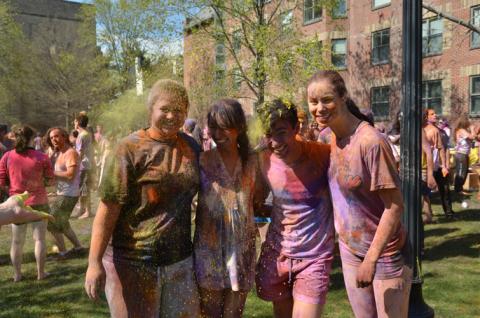Holi is a Hindu spring festival celebrating the advent of a new growing season and the strength of bhakti (devotion). But it also has an element of pure, unadulterated fun with the throwing of colored powder and water. The tradition of throwing colors harkens back to the adventures of Lord Krishna as a young man. Trying to prove his affection one day, he literally showered his lover Radha with colored powders. Inspired by Krishna’s playfulness, people celebrate Holi by throwing colors, squirting colored water, dancing, eating sweets and engaging in all sorts of mischievous merriment. The colors are made from flowers, turmeric, tulsi and other herbs and are said to protect against bacterial infections which become more common as the weather turns warm and moist.
Fire also takes on special significance during Holi as a marker of purification, renewal and spiritual resilience. Farmers prepare their fields by burning off the dried remains of last year’s crops, returning those nutrients back to the soil. For Holi people light giant bonfires in the evening. A priest will utter prayers as the bonfire is lit and offerings of coconuts and grains are heaped into the fire as ritual offerings. The roasted coconuts are then retrieved from the fire, opened and shared among the celebrants as a tasty treat.
Why light bonfires? The fire harkens back to an ancient story of Prince Prahlad, the son of the Demon King Hiranya Kashipu. The King had earned a boon that prevented him from being killed by a man or an animal, during the day or at night, while inside or outside or above or on the ground. Due to this boon, the King considered himself immortal and this fed his ego. Prince Prahlad was a staunch devotee of Lord Vishnu. The King, however, demanded that his subjects and his son worship him – and only him – as God. Prahlad refused. Incensed by the prince’s disobedience, King Hiranya Kashipu conjured many ways to kill the prince, none of which succeeded. Finally, he ordered his demoness sister Holika to destroy the boy. Holika had her own boon – she was impervious to fire. She drew Prahlad into a giant bonfire, attempting to burn him to death. The boy prayed to Lord Vishnu and emerged untouched by the flames. Holika, however, burned to death.
The building of bonfires during Holi, recalls the power of Prince Prahlad’s bhakti and the destruction of Holika. But what of the evil king? Many sacred scriptures recount times when the Divine has incarnated on Earth to restore justice in the face of great tyranny. In this case Lord Vishnu incarnated as Narasimha, a half lion and half man; He wrapped his immense arms around King Hiranya Kashipu and dragged him to a veranda. In this form, at the twilight hour and at the threshold of the veranda, Narasimha lifted the King up onto his knee and killed the king.
This sacred story serves as a reminder that tyranny, even when it seems entrenched, overwhelming and impenetrable, can and must be overturned. In a dharmic society the weak, the young, the disadvantaged, and the needy should be protected by the strong, the mature, the prosperous and the capable. While it is tempting to wait for divine intervention to enact change, if we are among the fortunate then it is our duty to draw attention to suffering and to toil for the common good. How we toil may differ, but strive we must, using the righteous flames of Holi to guide our way through the darkness.
Happy Holi everyone!
Dr. Asha Shipman
Director of Hindu Life
Yale University









